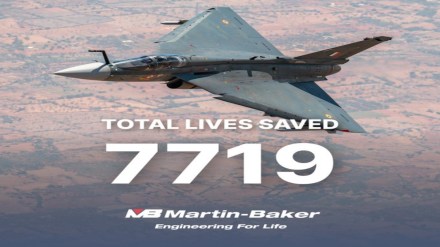In the first ever accident, an Indian Air Force Light Combat Aircraft `Tejas’ crashed during an operational training sortie near Jaisalmer, Rajasthan. Despite the accident, the pilot’s life was saved thanks to the remarkable technology of the UK based Martin-Baker IN16G Seat, which facilitated a successful ejection.
The significance of this event reverberated as Martin Baker, renowned for its contributions to aviation safety, celebrated yet another instance of its life-saving technology in action.
Soon after the news of the crash, and the successful ejection, Martin Baker posted on the social media X (former Twitter): “Martin Baker does it again! “The pilot ejected safely.” And that is what really matters.” That was the first major event on the `Tejas’ that otherwise held a clean record of 23 yrs.
Zero-zero-Hero
Fighter jets achieve incredibly high speeds, posing a risk of severe spinal injuries to pilots during ejection due to the intense forces involved. Ejection seats are highly intricate components of aircraft, with some models containing thousands of individual parts. The primary goal of an ejection seat is straightforward: It is designed to swiftly propel the pilot out of the aircraft to a secure distance and subsequently deploy a parachute for a safe landing.
“To mitigate this, engineers devised a system optimized for a specific speed and altitude. This innovation gave rise to the “zero-zero” ejection concept, allowing pilots to safely eject at ground level without any forward motion,” explains Bangalore based Girish Linganna, Defence Analyst.
Martin Baker introduced the zero-zero ejection seat, specifically the MK16 US16E seat used in the F-35 aircraft. This seat is the only one that meets the Neck Injury Criteria (NIC) standards for ejections.
The ejection seat is a critical safety component in military aircraft, designed to save the life of the pilot and, in some cases, additional crew members during an emergency.
According to Linganna, the importance of the ejection seat lies in several key aspects:
“Life-saving device: The primary purpose of an ejection seat is to allow the pilot to escape from an airplane that is no longer controllable or is expected to crash or be destroyed. This could be due to mechanical failure, damage from enemy fire, or collision.
Quick escape: Ejection seats are designed to rapidly propel occupants out of the aircraft with minimal effort required from them. This is vital in high-speed, high-stress situations where immediate action is necessary.
Altitude and speed constraints: Modern ejection seats are highly sophisticated and can save pilots even at extreme altitudes and speeds, both high and low, which would otherwise be unsurvivable.
Survival equipment: Ejection seats often come with integrated survival kits that include a parachute, a life raft, and other essential survival gear to sustain the pilot after ejection and until rescue, especially if the ejection occurs over hostile territory or water.
Psychological reassurance: Knowing that there is a means of escape can provide pilots with the confidence needed to undertake risky missions and focus on their tasks without being overly preoccupied with their personal safety.
Training and readiness: Ejection seats have also influenced how pilots are trained and prepared for emergency situations, with regular ejection seat drills being a part of their routine.
Evolution of aircraft design: The presence of ejection seats has guided the design of cockpits and aircraft structures to accommodate the safe ejection of the seat and occupant.
Combat effectiveness: Pilots may be more willing to push their aircraft to the limits of its capabilities during combat if they know they have a reliable means of escape.”
Ejecting from an aircraft traveling faster than the speed of sound can be extremely risky. The impact of ejection at such high speeds can exceed 20 Gs, equivalent to 20 times the pilot’s body weight, resulting in severe injuries or fatalities.
“While ejection seats are crucial, they are not without risk. The ejection process is violent and can cause significant injury to the aviator, such as spinal compression fractures,” he explains. However, he states these risks are generally considered acceptable compared to the almost certain fatality that would result from remaining in an aircraft that is going to crash.
